Home / Regiochemistry In The Diels-Alder Reaction
Dienes and MO Theory
Regiochemistry In The Diels-Alder Reaction
Last updated: November 10th, 2025 |
Regiochemistry (“Regioselectivity”) In The Diels-Alder Reaction
The Diels-Alder is an onion, and we just keep peeling back the layers.
- When non-symmetrical dienes react with non-symmetrical dienophiles, two regioisomers (constitutional isomers) are possible.
- Dienes with substituents on the terminus (“1-substituted dienes”) tend to give “1,2” products (nicknamed “ortho”).
- Dienes with substituents on the 2-position (“2-substituted dienes”) tend to give the “1,4” product (nicknamed “para”).
- In general, “1,3” products (“meta”) are only minor byproducts.
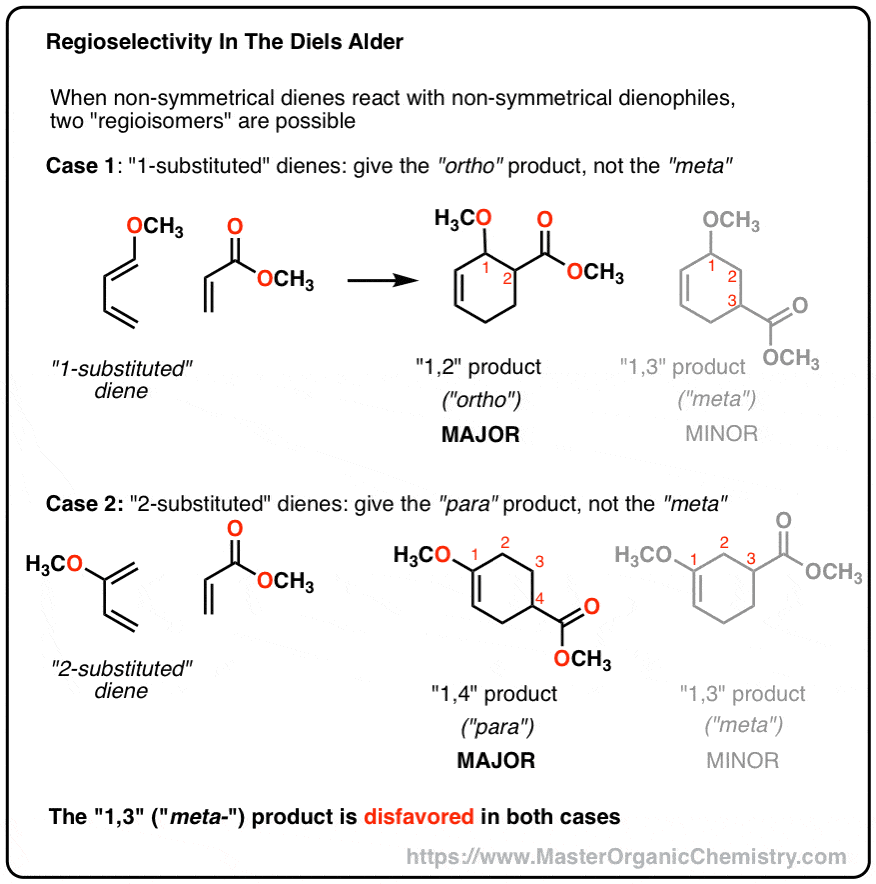
Table of Contents
- Regiochemistry In The Diels-Alder Reaction
- Flashback: Markovnikov’s Rule and “Regioselectivity”
- The Diels-Alder Reaction Is Regioselective
- Summary: Regioselectivity In The Diels-Alder Reaction
- Notes (more on the origin of regioselectivity)
- Quiz Yourself!
- (Advanced) References and Further Reading
1. “Regiochemistry” In The Diels-Alder Reaction
So far in the Diels-Alder, we’ve seen examples of:
- symmetrical dienes with symmetrical dienophiles
- unsymmetrical dienes with symmetrical dienophiles
- symmetrical dienes with unsymmetrical dienophiles
These three situations (laid out in the image below) each have the potential to form stereoisomers (i.e. diastereomers and/or enantiomers). But all the products have exactly the same connectivity.
This brings us to a particularly challenging case. What happens when we have an unsymmetrical diene reacting with an unsymmetrical dienophile?
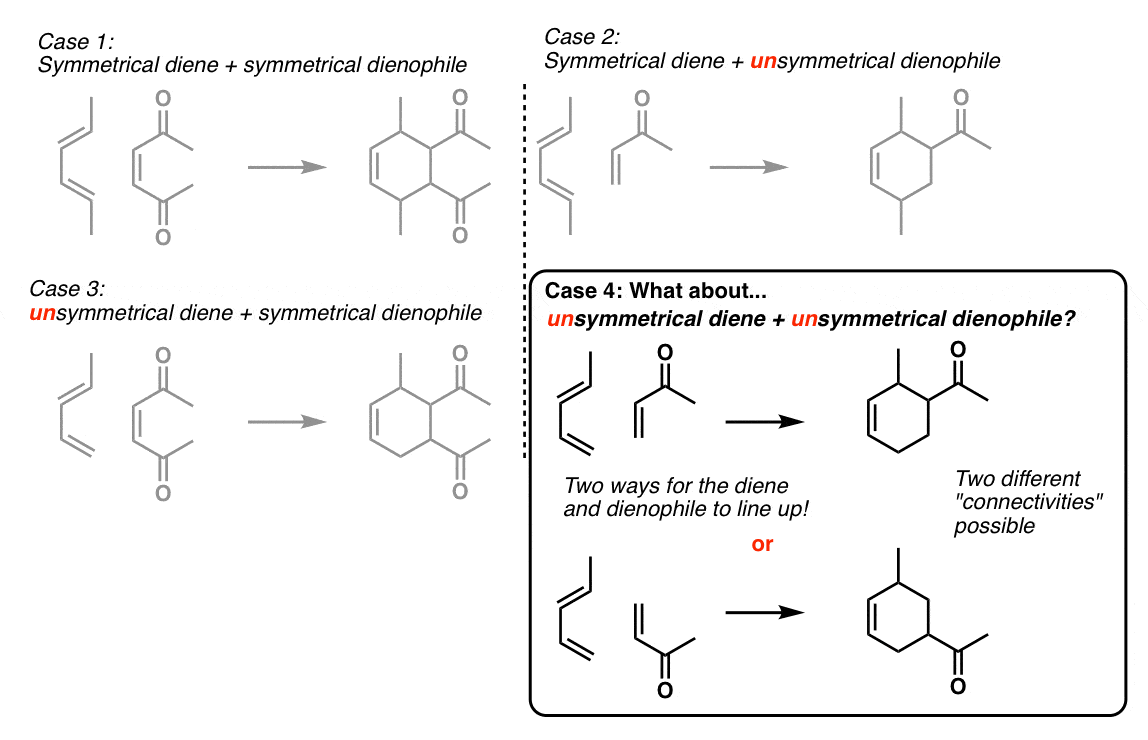
Why is this situation different from the first three?
Because there are two different ways for the diene and dienophile to “line up! “. In the example above, the diene and dienophile can come together two ways:
- “head to head” such that the methyl group on the diene and the C=O bond point in the same direction (giving the top product);
- “head to tail” such that they point in the opposite direction (bottom product).
How are these products related to each other, overall (not counting stereochemistry)?
Since they have the same molecular formula but different connectivity, they’re constitutional isomers.
Now comes the big question. In this kind of a Diels-Alder, are these products formed in roughly equal ratios… or is there a preference for one type of connectivity over another?
The short answer is, “yes, the Diels-Alder has a preference for one type of connectivity.”
In other words, the reaction has regioselectivity.
Wait. What’s regioselectivity? Quick review:
2. Flashback: Markovnikov’s Rule and “Regioselectivity”
Where have we seen this type of situation before?
With alkenes! We saw that adding an acid like HCl to an alkene like 1-butene, we could obtain two possible products: 1-chlorobutane or 2-chlorobutane. [See: Markovnikov’s Rule]
These products have the same molecular formula, but different connectivity, which makes them constitutional isomers.
However, we saw that the reaction doesn’t give an equal ratio of products. Instead, there’s about a 4:1 preference for 2-chlorobutane over 1-chlorobutane, which we saw was due to a greater preference for the more stable carbocation intermediate.
This preference goes by the name “Markovnikov’s Rule”:
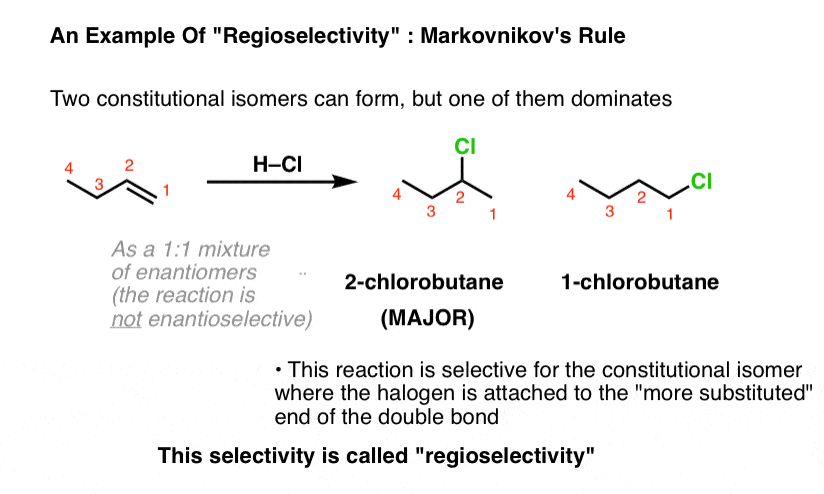
The tendency of alkenes to obey “Markovnikov’s rule” in these reactions is an example of regioselectivity. The reaction is selective in forming one constitutional isomer over another.
(We say “selective” and not “specific” because more than one product is formed. Use of the prefix “regio” comes from the observation that the chloride tends to attack one region of the double bond, and the proton, another. )
It’s worth noting that 2-chlorobutane is formed as a racemic mixture of enantiomers. So while the reaction is regioselective, it is not enantioselective.
3. The Diels Alder Is Regioselective
Like the reaction of acids with alkenes, the Diels-Alder reaction is regioselective. Two main cases will illustrate the point.
Case 1: 1-substituted dienes
The first important case concerns a diene with a substituent on the “1” position of the diene, such as 1-methoxybutadiene. (I know that if a methyl group were present instead, it would technically be the “4” position according to IUPAC – bear with me on this).
Consider the Diels-Alder of 1-methoxy butadiene with methyl methacrylate. There are two ways that the diene and dienophile can connect.
- Line it up one way (“head to head“, below), and you get a new six-membered ring where two substituents are on two adjacent carbons (a “1,2” relationship)
- Line it up another way (“head to tail“), and the two substituents have a “1,3” relationship.
These two products have different connectivity and are therefore constitutional isomers (“regioisomers”).
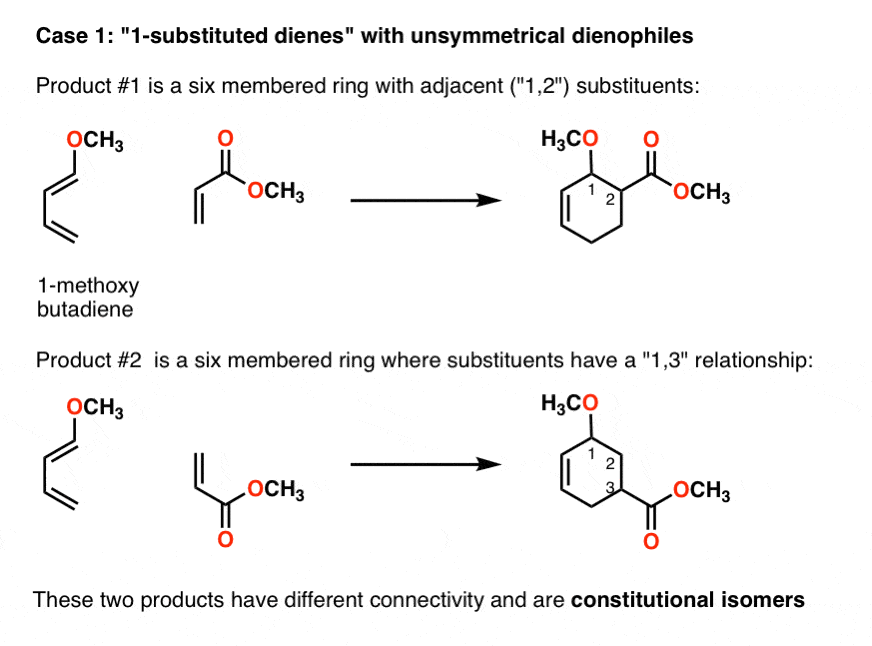
By analogy to aromatic nomenclature, the “1,2” and “1,3” patterns are nicknamed ortho- and meta- respectively. [I say “nicknamed” because these are terms of convenience, nothing else. Don’t tell IUPAC!]
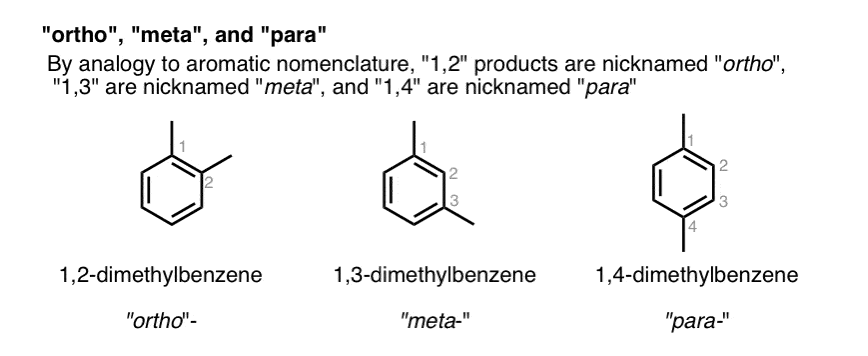
So which of the two Diels-Alder products is favored? The “ortho” or the “meta” ?
Here’s what’s experiments tell us:
The ortho product is major and the meta product is minor.
This holds for a large number of 1-substituted dienes; I’ll just show two. Hans Reich at UW-Madison has a longer list of examples – see here.
- With 1-methoxybutadiene, the ortho is the only product!!
- When a methyl group is in that position, the ortho outnumbers meta by about 8:1
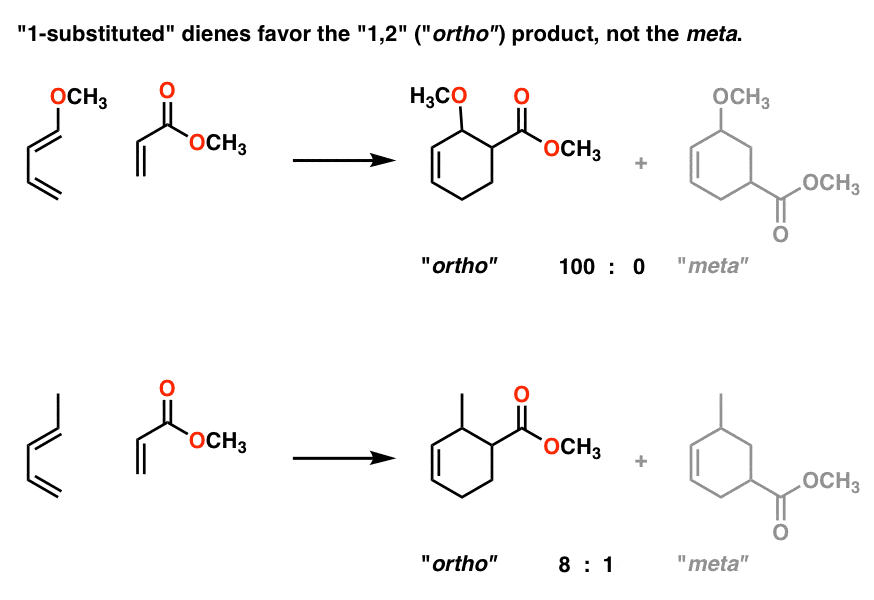
Case 2: 2-substituted dienes
The second important case is when there’s a substituent on the 2-position of the diene, such as 2-methylbutadiene.
Again, there are two ways it can line up, except this time it’s to provide para (1,4) and meta (1,3) products.
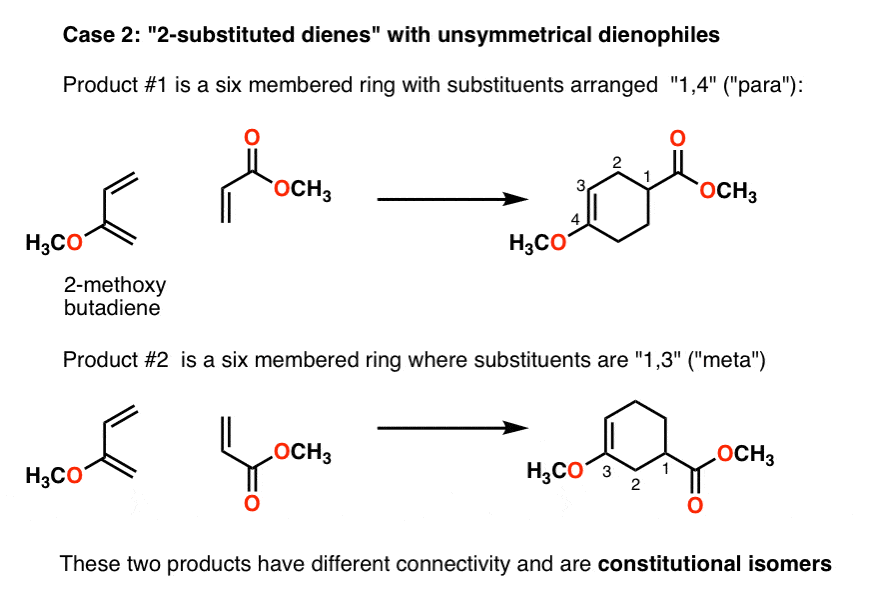
So which of these products is dominant?
The para product is major and the meta product is minor.
- 2-methoxybutadiene favors the para product by about 8:1
- 2-methylbutadiene favors the para product by about 2:1
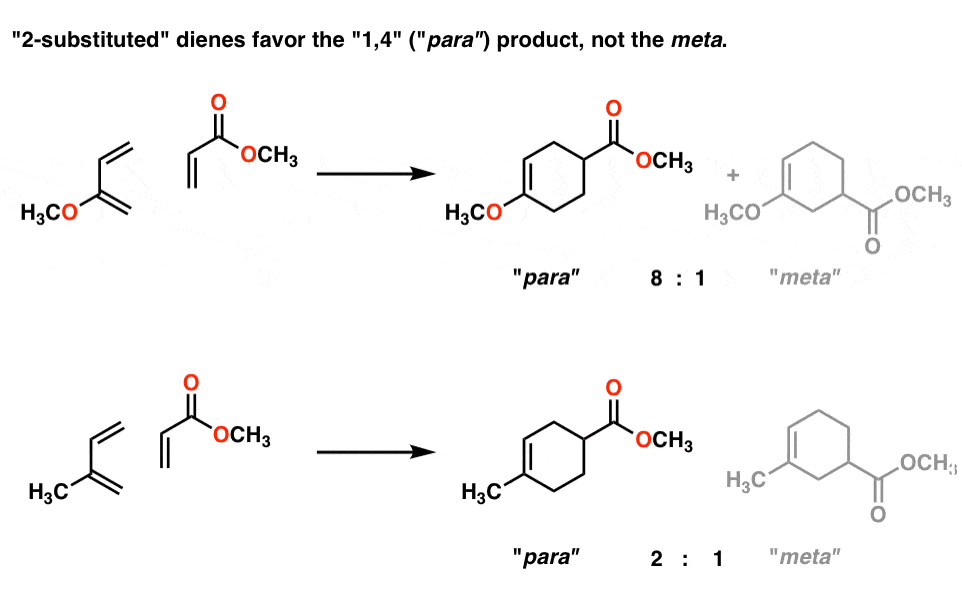
What if there’s substituents on both the 1- and 2- positions? In these cases, it turns out that the substituent on the 1-position is more powerful at directing the products. [See Note 1]
4. Summary: Regiochemistry In The Diels-Alder Reaction
Avoid the meta- product (1,3). That’s really it.
So why does the Diels-Alder wind up this way?
Good question.
For the answer, read on…..
Notes
Related Articles
Quiz Yourself!
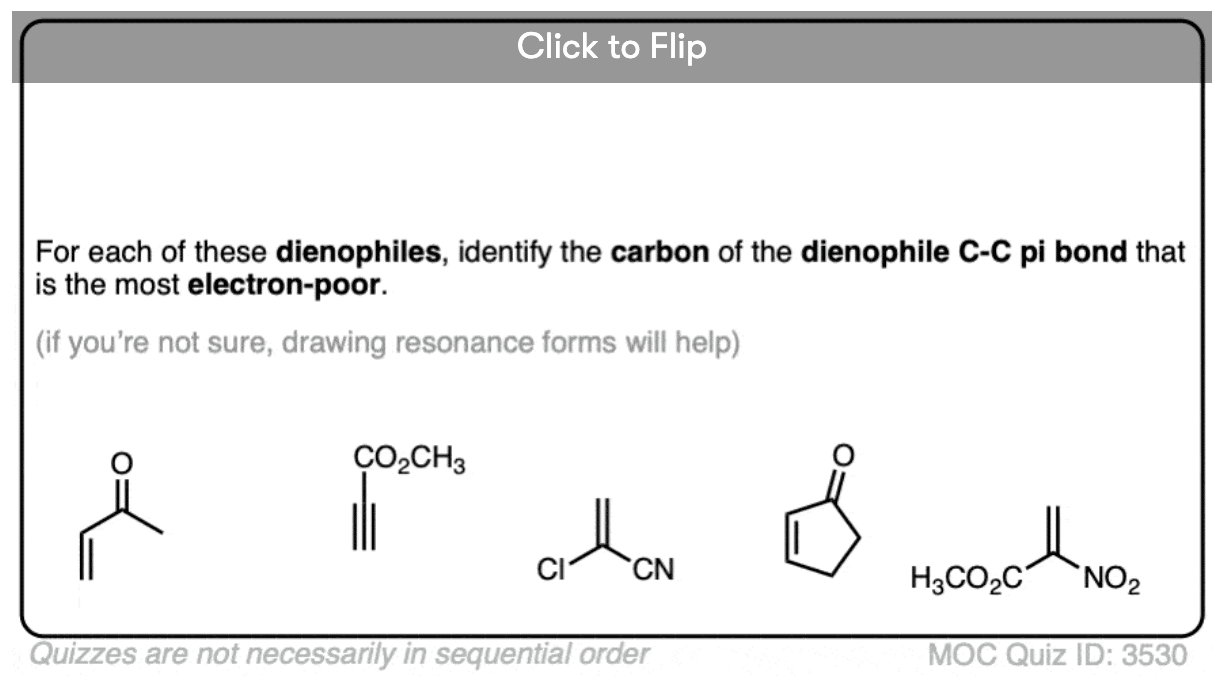
Become a MOC member to see the clickable quiz with answers on the back.
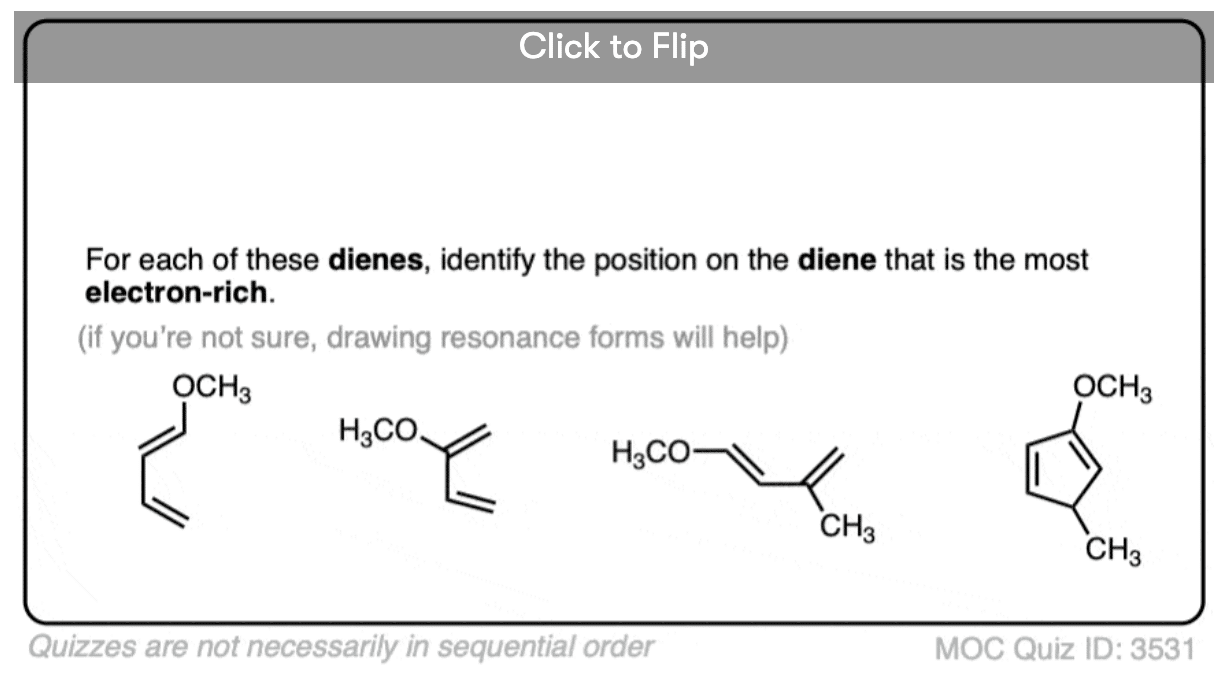
Become a MOC member to see the clickable quiz with answers on the back.
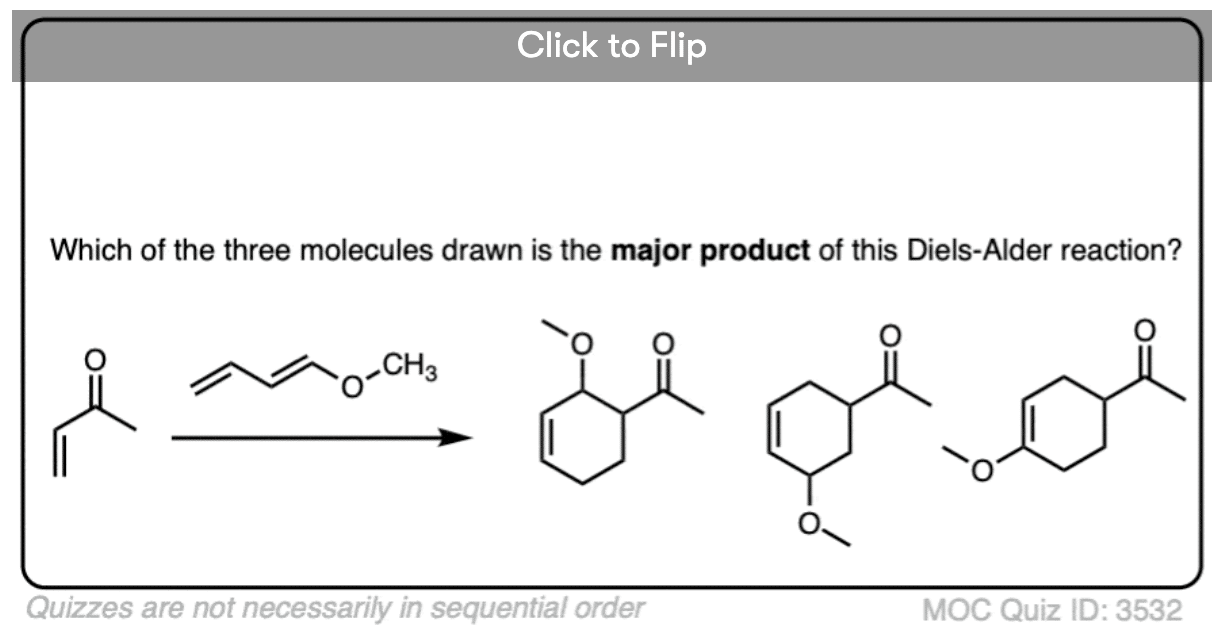
Become a MOC member to see the clickable quiz with answers on the back.
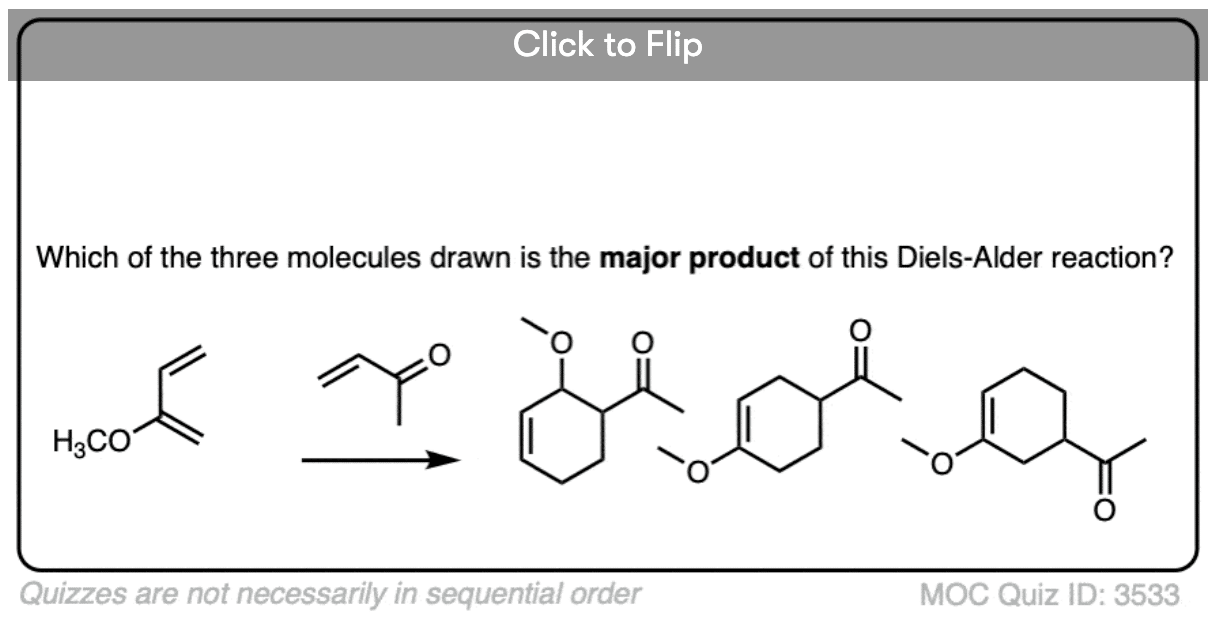
Become a MOC member to see the clickable quiz with answers on the back.
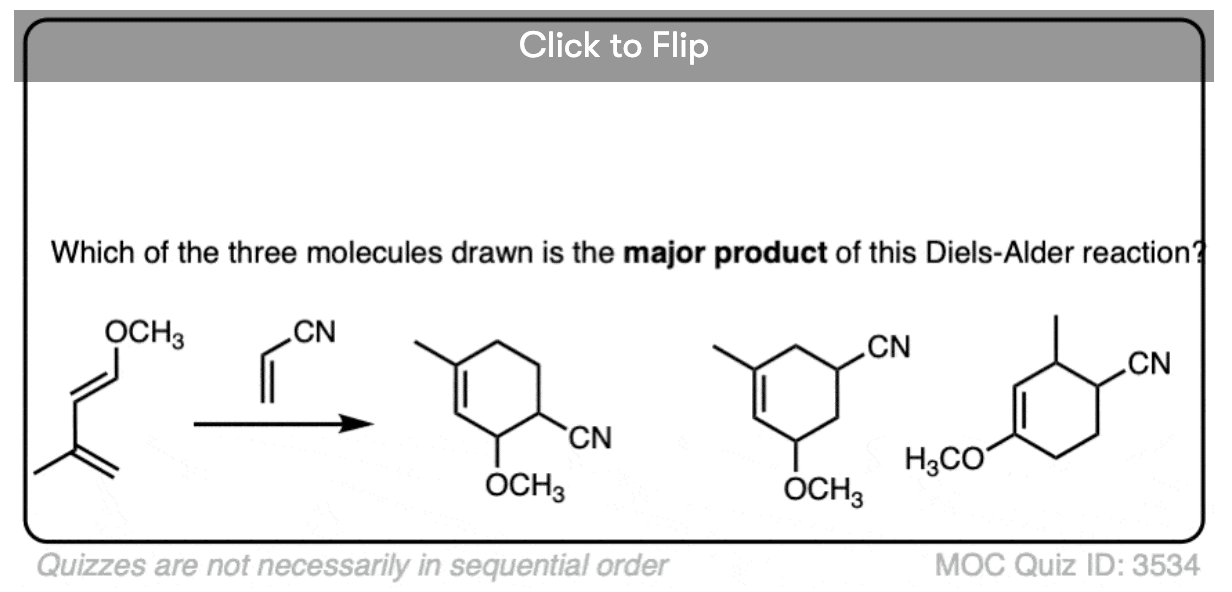
Become a MOC member to see the clickable quiz with answers on the back.
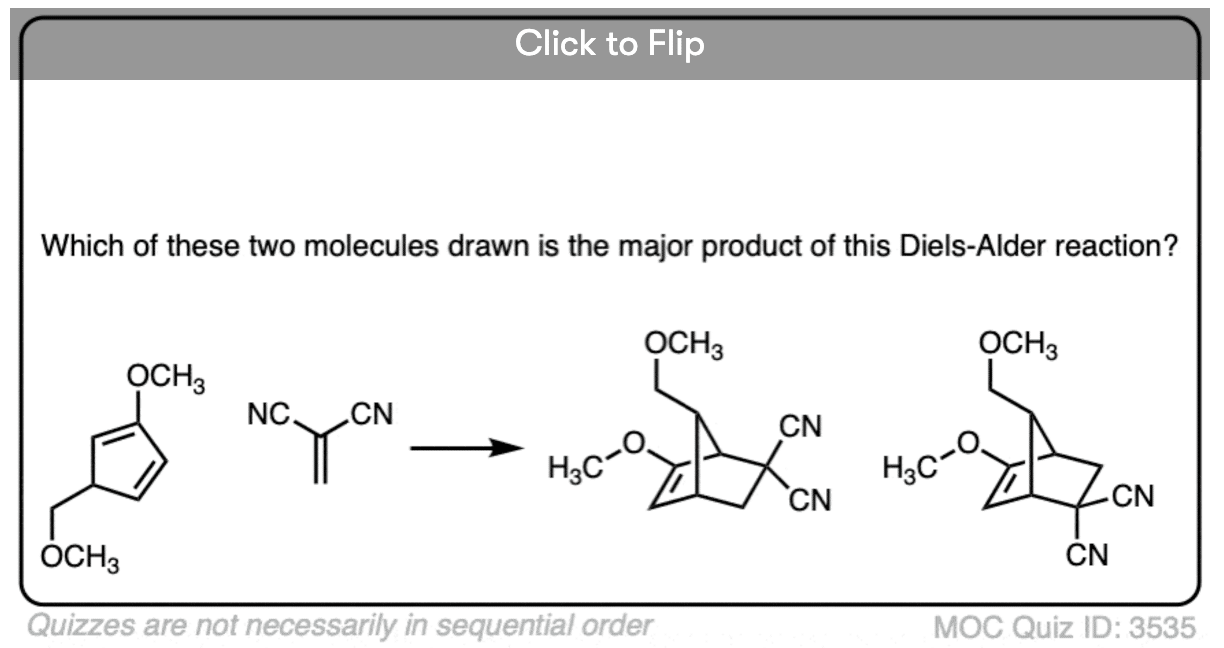
Become a MOC member to see the clickable quiz with answers on the back.
Understanding Regioselectivity
It can be helpful to think of the diene as a nucleophile and the dienophile as the electrophile.
The dominant product will be the one where the most nucleophilic carbon on the diene lines up with the most electrophilic carbon on the dienophile.
So how do we determine what these carbons are?
- Look for the second-best resonance form of the diene and the dienophile! (sometimes known as Grossman’s rule)
- Line up the negative charge on the diene with the positive charge on the dienophile.
This will get you to the right result!
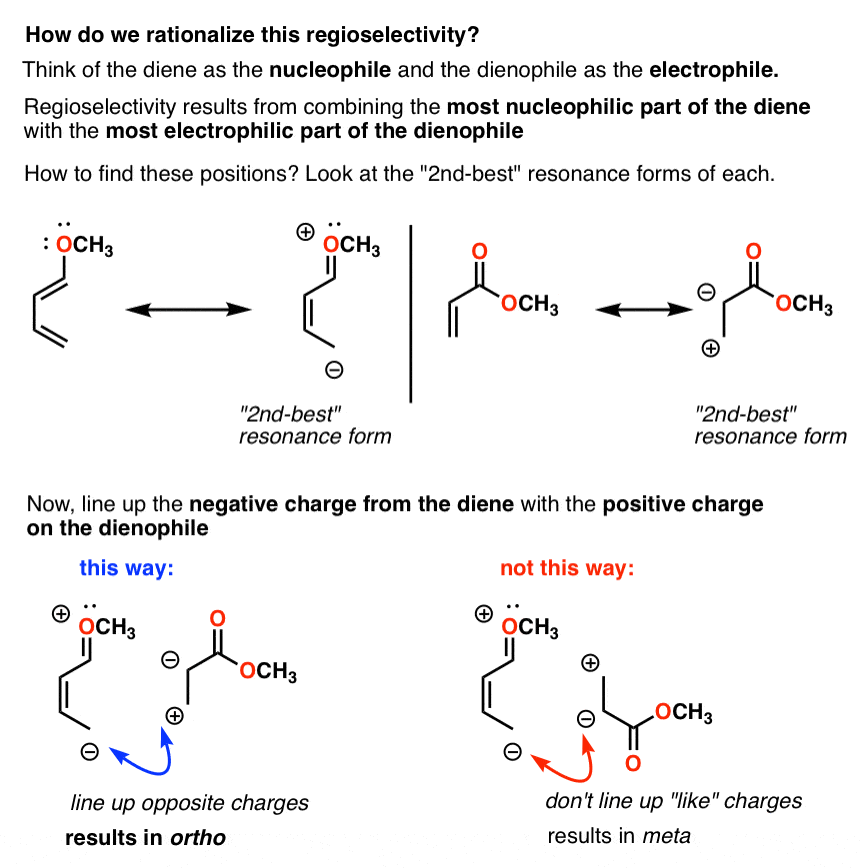
Note how this results in the ortho– product and not the meta- product, just like what’s observed in experiment.
What about 2-substituted dienes?
Same process. Draw out the “second-best” resonance form. Now line up the negative charge on the nucleophile with the positive charge on the “2nd best” resonance form of the electrophile:
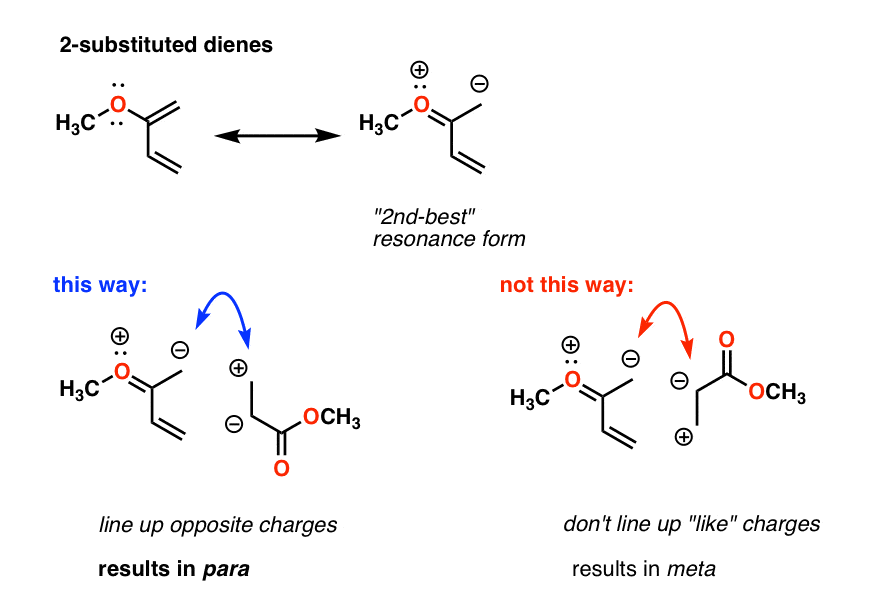
Note how this correctly predicts the para product will be favored over the meta product.
That’s it.
Now… is this really the best way to do it?
For our purposes, yes.
For more advanced purposes… we rely on molecular orbital calculations. In advanced courses, we talk a lot about the size of “coefficients” on the HOMO or LUMO of the diene/dienophile, and we’re not going there. If you are interested in this topic, I highly recommend Ian Fleming’s Frontier Orbitals and Organic Chemical Reactions. Classic book.
What About 1,2-Substituted Dienes?
Note 1. What if they’re both substituted? Here’s a practical example.
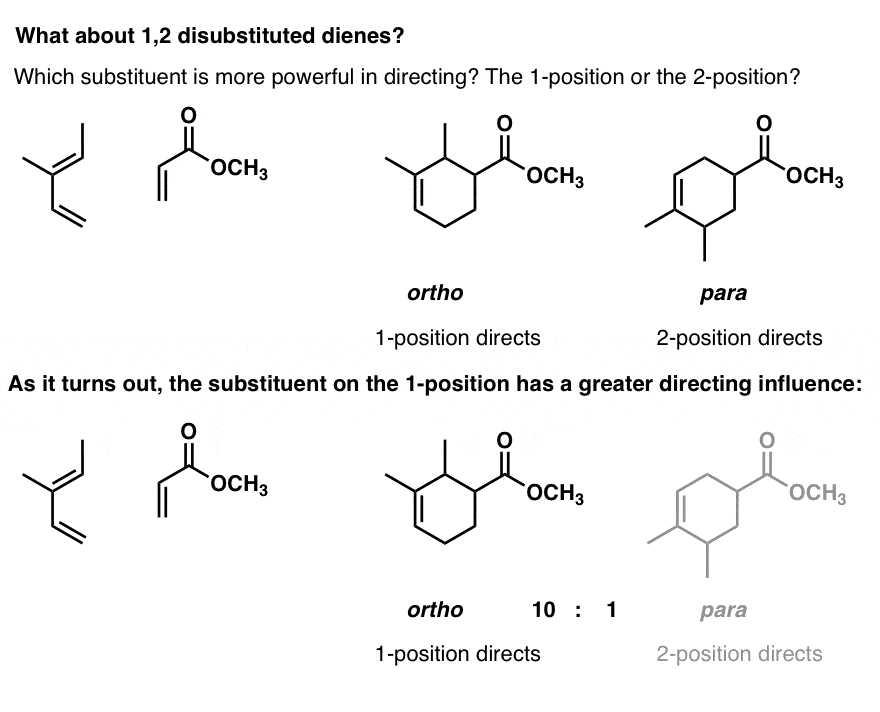
What’s observed is that the 1-position on the diene has a greater influence on the product than the 2-position.
(Advanced) References and Further Reading
- Frontier molecular orbital theory of cycloaddition reactions
Kendall N. Houk
Accounts of Chemical Research 1975, 8 (11), 361-369
DOI: 10.1021/ar50095a001 - Generalized frontier orbitals of alkenes and dienes. Regioselectivity in Diels-Alder reactions
K. N. Houk
Journal of the American Chemical Society 1973, 95 (12), 4092-4094
DOI: 10.1021/ja00793a069 - Modeling chemical reactivity. 1. Regioselectivity of Diels-Alder cycloadditions of electron-rich dienes with electron-deficient dienophiles
D. Kahn, C. F. Pau, L. E. Overman, and Warren J. Hehre
Journal of the American Chemical Society 1986, 108 (23), 7381-7396
DOI: 10.1021/ja00283a038 - Quantitative Characterization of the Local Electrophilicity of Organic Molecules. Understanding the Regioselectivity on Diels−Alder Reactions
Luis R. Domingo, M. José Aurell, Patricia Pérez, and Renato Contreras
The Journal of Physical Chemistry A 2002, 106 (29), 6871-6875
DOI: 10.1021/jp020715j - The regioselectivity of the diels-alder reaction between a diene with an electron-donating substituent and a dienophile with an electron-donating substituent: a test case for frontier orbital theory
Ian Fleming, Federico L. Gianni, Talat Mah
Tetrahedron Lett. 1976, 17 (11), 881-884
DOI: 10.1016/S0040-4039(00)92909-5
Better than the Ian Fleming of James Bond fame – but his book on Frontier Molecular Orbital theory is excellent and recommended for all advanced students of organic chemistry. - Regioselectivity in Hetero Diels–Alder Reactions
Carla Grosso, Marta Liber, Amadeu F. Brigas, Teresa M. V. D. Pinho e Melo, and Américo Lemos
Journal of Chemical Education 2019, 96 (1), 148-152
DOI: 10.1021/acs.jchemed.7b00933 - On the Brassard’s rule of regioselectivity in Diels–Alder reactions between haloquinones and polar dienes
Mauricio Maldonado-Domínguez, Karen Ruiz-Pérez, Oscar González-Antonio, Margarita Romero-Ávila, José Méndez-Stivalet and Blas Flores-Pérez
RSC Adv., 2016, 6, 75194-75201
DOI: 10.1039/C6RA14073D - Origins of Regioselectivity of Diels−Alder Reactions for the Synthesis of Bisanthraquinone Antibiotic BE-43472B
Amy E. Hayden, Robert S. Paton, Jochen Becker, Yee Hwee Lim, K. C. Nicolaou, and K. N. Houk
The Journal of Organic Chemistry 2010, 75 (3), 922-928
DOI: 10.1021/jo902572y
Experimental and theoretical study on a particularly complex diene/dienophile pairing.
00 General Chemistry Review
01 Bonding, Structure, and Resonance
- How Do We Know Methane (CH4) Is Tetrahedral?
- Hybrid Orbitals and Hybridization
- How To Determine Hybridization: A Shortcut
- Orbital Hybridization And Bond Strengths
- Sigma bonds come in six varieties: Pi bonds come in one
- Dipole Moments and Dipoles
- A Key Skill: How to Calculate Formal Charge
- The Four Intermolecular Forces and How They Affect Boiling Points
- 3 Trends That Affect Boiling Points
- How To Use Electronegativity To Determine Electron Density (and why NOT to trust formal charge)
- Introduction to Resonance
- How To Use Curved Arrows To Interchange Resonance Forms
- Evaluating Resonance Forms (1) - The Rule of Least Charges
- How To Find The Best Resonance Structure By Applying Electronegativity
- Evaluating Resonance Structures With Negative Charges
- Evaluating Resonance Structures With Positive Charge
- Exploring Resonance: Pi-Donation
- Exploring Resonance: Pi-acceptors
- In Summary: Evaluating Resonance Structures
- Drawing Resonance Structures: 3 Common Mistakes To Avoid
- How to apply electronegativity and resonance to understand reactivity
- Bond Hybridization Practice
- Structure and Bonding Practice Quizzes
- Resonance Structures Practice
02 Acid Base Reactions
- Introduction to Acid-Base Reactions
- Acid Base Reactions In Organic Chemistry
- The Stronger The Acid, The Weaker The Conjugate Base
- Walkthrough of Acid-Base Reactions (3) - Acidity Trends
- Five Key Factors That Influence Acidity
- Acid-Base Reactions: Introducing Ka and pKa
- How to Use a pKa Table
- The pKa Table Is Your Friend
- A Handy Rule of Thumb for Acid-Base Reactions
- Acid Base Reactions Are Fast
- pKa Values Span 60 Orders Of Magnitude
- How Protonation and Deprotonation Affect Reactivity
- Acid Base Practice Problems
03 Alkanes and Nomenclature
- Meet the (Most Important) Functional Groups
- Condensed Formulas: Deciphering What the Brackets Mean
- Hidden Hydrogens, Hidden Lone Pairs, Hidden Counterions
- Don't Be Futyl, Learn The Butyls
- Primary, Secondary, Tertiary, Quaternary In Organic Chemistry
- Branching, and Its Affect On Melting and Boiling Points
- The Many, Many Ways of Drawing Butane
- Wedge And Dash Convention For Tetrahedral Carbon
- Common Mistakes in Organic Chemistry: Pentavalent Carbon
- Table of Functional Group Priorities for Nomenclature
- Summary Sheet - Alkane Nomenclature
- Organic Chemistry IUPAC Nomenclature Demystified With A Simple Puzzle Piece Approach
- Boiling Point Quizzes
- Organic Chemistry Nomenclature Quizzes
04 Conformations and Cycloalkanes
- Staggered vs Eclipsed Conformations of Ethane
- Conformational Isomers of Propane
- Newman Projection of Butane (and Gauche Conformation)
- Introduction to Cycloalkanes
- Geometric Isomers In Small Rings: Cis And Trans Cycloalkanes
- Calculation of Ring Strain In Cycloalkanes
- Cycloalkanes - Ring Strain In Cyclopropane And Cyclobutane
- Cyclohexane Conformations
- Cyclohexane Chair Conformation: An Aerial Tour
- How To Draw The Cyclohexane Chair Conformation
- The Cyclohexane Chair Flip
- The Cyclohexane Chair Flip - Energy Diagram
- Substituted Cyclohexanes - Axial vs Equatorial
- Ranking The Bulkiness Of Substituents On Cyclohexanes: "A-Values"
- Cyclohexane Chair Conformation Stability: Which One Is Lower Energy?
- Fused Rings - Cis-Decalin and Trans-Decalin
- Naming Bicyclic Compounds - Fused, Bridged, and Spiro
- Bredt's Rule (And Summary of Cycloalkanes)
- Newman Projection Practice
- Cycloalkanes Practice Problems
05 A Primer On Organic Reactions
- The Most Important Question To Ask When Learning a New Reaction
- Curved Arrows (for reactions)
- Nucleophiles and Electrophiles
- The Three Classes of Nucleophiles
- Nucleophilicity vs. Basicity
- What Makes A Good Nucleophile?
- What Makes A Good Leaving Group?
- 3 Factors That Stabilize Carbocations
- Equilibrium and Energy Relationships
- 7 Factors that stabilize negative charge in organic chemistry
- 7 Factors That Stabilize Positive Charge in Organic Chemistry
- What's a Transition State?
- Hammond's Postulate
- Learning Organic Chemistry Reactions: A Checklist (PDF)
06 Free Radical Reactions
- Free Radical Reactions
- 3 Factors That Stabilize Free Radicals
- Bond Strengths And Radical Stability
- Free Radical Initiation: Why Is "Light" Or "Heat" Required?
- Initiation, Propagation, Termination
- Monochlorination Products Of Propane, Pentane, And Other Alkanes
- Selectivity In Free Radical Reactions
- Selectivity in Free Radical Reactions: Bromination vs. Chlorination
- Halogenation At Tiffany's
- Allylic Bromination
- Bonus Topic: Allylic Rearrangements
- In Summary: Free Radicals
- Synthesis (2) - Reactions of Alkanes
- Free Radicals Practice Quizzes
07 Stereochemistry and Chirality
- Types of Isomers: Constitutional Isomers, Stereoisomers, Enantiomers, and Diastereomers
- How To Draw The Enantiomer Of A Chiral Molecule
- How To Draw A Bond Rotation
- Introduction to Assigning (R) and (S): The Cahn-Ingold-Prelog Rules
- Assigning Cahn-Ingold-Prelog (CIP) Priorities (2) - The Method of Dots
- Enantiomers vs Diastereomers vs The Same? Two Methods For Solving Problems
- Assigning R/S To Newman Projections (And Converting Newman To Line Diagrams)
- How To Determine R and S Configurations On A Fischer Projection
- The Meso Trap
- Optical Rotation, Optical Activity, and Specific Rotation
- Optical Purity and Enantiomeric Excess
- What's a Racemic Mixture?
- Chiral Allenes And Chiral Axes
- Stereochemistry Practice Problems and Quizzes
08 Substitution Reactions
- Nucleophilic Substitution Reactions - Introduction
- Two Types of Nucleophilic Substitution Reactions
- The SN2 Mechanism
- Why the SN2 Reaction Is Powerful
- The SN1 Mechanism
- The Conjugate Acid Is A Better Leaving Group
- Comparing the SN1 and SN2 Reactions
- Polar Protic? Polar Aprotic? Nonpolar? All About Solvents
- Steric Hindrance is Like a Fat Goalie
- Common Blind Spot: Intramolecular Reactions
- Substitution Practice - SN1
- Substitution Practice - SN2
09 Elimination Reactions
- Elimination Reactions (1): Introduction And The Key Pattern
- Elimination Reactions (2): The Zaitsev Rule
- Elimination Reactions Are Favored By Heat
- Two Elimination Reaction Patterns
- The E1 Reaction
- The E2 Mechanism
- E1 vs E2: Comparing the E1 and E2 Reactions
- Antiperiplanar Relationships: The E2 Reaction and Cyclohexane Rings
- Bulky Bases in Elimination Reactions
- Comparing the E1 vs SN1 Reactions
- Elimination (E1) Reactions With Rearrangements
- E1cB - Elimination (Unimolecular) Conjugate Base
- Elimination (E1) Practice Problems And Solutions
- Elimination (E2) Practice Problems and Solutions
10 Rearrangements
11 SN1/SN2/E1/E2 Decision
- Identifying Where Substitution and Elimination Reactions Happen
- Deciding SN1/SN2/E1/E2 (1) - The Substrate
- Deciding SN1/SN2/E1/E2 (2) - The Nucleophile/Base
- SN1 vs E1 and SN2 vs E2 : The Temperature
- Deciding SN1/SN2/E1/E2 - The Solvent
- Wrapup: The Key Factors For Determining SN1/SN2/E1/E2
- Alkyl Halide Reaction Map And Summary
- SN1 SN2 E1 E2 Practice Problems
12 Alkene Reactions
- E and Z Notation For Alkenes (+ Cis/Trans)
- Alkene Stability
- Alkene Addition Reactions: "Regioselectivity" and "Stereoselectivity" (Syn/Anti)
- Stereoselective and Stereospecific Reactions
- Hydrohalogenation of Alkenes and Markovnikov's Rule
- Hydration of Alkenes With Aqueous Acid
- Rearrangements in Alkene Addition Reactions
- Halogenation of Alkenes and Halohydrin Formation
- Oxymercuration Demercuration of Alkenes
- Hydroboration Oxidation of Alkenes
- m-CPBA (meta-chloroperoxybenzoic acid)
- OsO4 (Osmium Tetroxide) for Dihydroxylation of Alkenes
- Palladium on Carbon (Pd/C) for Catalytic Hydrogenation of Alkenes
- Cyclopropanation of Alkenes
- A Fourth Alkene Addition Pattern - Free Radical Addition
- Alkene Reactions: Ozonolysis
- Oxidative Cleavage of Vicinal Diols With NaIO4 and Pb(OAc)4
- Summary: Three Key Families Of Alkene Reaction Mechanisms
- Synthesis (4) - Alkene Reaction Map, Including Alkyl Halide Reactions
- Alkene Reactions Practice Problems
13 Alkyne Reactions
- Acetylides from Alkynes, And Substitution Reactions of Acetylides
- Partial Reduction of Alkynes With Lindlar's Catalyst
- Partial Reduction of Alkynes With Na/NH3 To Obtain Trans Alkenes
- Alkyne Hydroboration With "R2BH"
- Hydration and Oxymercuration of Alkynes
- Hydrohalogenation of Alkynes
- Alkyne Halogenation: Bromination and Chlorination of Alkynes
- Oxidation of Alkynes With O3 and KMnO4
- Alkenes To Alkynes Via Halogenation And Elimination Reactions
- Alkynes Are A Blank Canvas
- Synthesis (5) - Reactions of Alkynes
- Alkyne Reactions Practice Problems With Answers
14 Alcohols, Epoxides and Ethers
- Alcohols - Nomenclature and Properties
- Alcohols Can Act As Acids Or Bases (And Why It Matters)
- Alcohols - Acidity and Basicity
- The Williamson Ether Synthesis
- Ethers From Alkenes, Tertiary Alkyl Halides and Alkoxymercuration
- Alcohols To Ethers via Acid Catalysis
- Cleavage Of Ethers With Acid
- Epoxides - The Outlier Of The Ether Family
- Opening of Epoxides With Acid
- Epoxide Ring Opening With Base
- Making Alkyl Halides From Alcohols
- Tosylates And Mesylates
- PBr3 and SOCl2
- Elimination Reactions of Alcohols
- Elimination of Alcohols To Alkenes With POCl3
- Alcohol Oxidation: "Strong" and "Weak" Oxidants
- Demystifying The Mechanisms of Alcohol Oxidations
- Protecting Groups For Alcohols
- Thiols And Thioethers
- Calculating the oxidation state of a carbon
- Oxidation and Reduction in Organic Chemistry
- Oxidation Ladders
- SOCl2 Mechanism For Alcohols To Alkyl Halides: SN2 versus SNi
- Alcohol Reactions Roadmap (PDF)
- Alcohol Reaction Practice Problems
- Epoxide Reaction Quizzes
- Oxidation and Reduction Practice Quizzes
15 Organometallics
- What's An Organometallic?
- Formation of Grignard and Organolithium Reagents
- Organometallics Are Strong Bases
- Reactions of Grignard Reagents
- Protecting Groups In Grignard Reactions
- Synthesis Problems Involving Grignard Reagents
- Grignard Reactions And Synthesis (2)
- Organocuprates (Gilman Reagents): How They're Made
- Gilman Reagents (Organocuprates): What They're Used For
- The Heck, Suzuki, and Olefin Metathesis Reactions (And Why They Don't Belong In Most Introductory Organic Chemistry Courses)
- Reaction Map: Reactions of Organometallics
- Grignard Practice Problems
16 Spectroscopy
- Degrees of Unsaturation (or IHD, Index of Hydrogen Deficiency)
- Conjugation And Color (+ How Bleach Works)
- Introduction To UV-Vis Spectroscopy
- UV-Vis Spectroscopy: Absorbance of Carbonyls
- UV-Vis Spectroscopy: Practice Questions
- Bond Vibrations, Infrared Spectroscopy, and the "Ball and Spring" Model
- Infrared (IR) Spectroscopy: A Quick Primer On Interpreting Spectra
- IR Spectroscopy: 4 Practice Problems
- 1H NMR: How Many Signals?
- Homotopic, Enantiotopic, Diastereotopic
- Diastereotopic Protons in 1H NMR Spectroscopy: Examples
- 13-C NMR - How Many Signals
- Liquid Gold: Pheromones In Doe Urine
- Natural Product Isolation (1) - Extraction
- Natural Product Isolation (2) - Purification Techniques, An Overview
- Structure Determination Case Study: Deer Tarsal Gland Pheromone
17 Dienes and MO Theory
- What To Expect In Organic Chemistry 2
- Are these molecules conjugated?
- Conjugation And Resonance In Organic Chemistry
- Bonding And Antibonding Pi Orbitals
- Molecular Orbitals of The Allyl Cation, Allyl Radical, and Allyl Anion
- Pi Molecular Orbitals of Butadiene
- Reactions of Dienes: 1,2 and 1,4 Addition
- Thermodynamic and Kinetic Products
- More On 1,2 and 1,4 Additions To Dienes
- s-cis and s-trans
- The Diels-Alder Reaction
- Cyclic Dienes and Dienophiles in the Diels-Alder Reaction
- Stereochemistry of the Diels-Alder Reaction
- Exo vs Endo Products In The Diels Alder: How To Tell Them Apart
- HOMO and LUMO In the Diels Alder Reaction
- Why Are Endo vs Exo Products Favored in the Diels-Alder Reaction?
- Diels-Alder Reaction: Kinetic and Thermodynamic Control
- The Retro Diels-Alder Reaction
- The Intramolecular Diels Alder Reaction
- Regiochemistry In The Diels-Alder Reaction
- The Cope and Claisen Rearrangements
- Electrocyclic Reactions
- Electrocyclic Ring Opening And Closure (2) - Six (or Eight) Pi Electrons
- Diels Alder Practice Problems
- Molecular Orbital Theory Practice
18 Aromaticity
- Introduction To Aromaticity
- Rules For Aromaticity
- Huckel's Rule: What Does 4n+2 Mean?
- Aromatic, Non-Aromatic, or Antiaromatic? Some Practice Problems
- Antiaromatic Compounds and Antiaromaticity
- The Pi Molecular Orbitals of Benzene
- The Pi Molecular Orbitals of Cyclobutadiene
- Frost Circles
- Aromaticity Practice Quizzes
19 Reactions of Aromatic Molecules
- Electrophilic Aromatic Substitution: Introduction
- Activating and Deactivating Groups In Electrophilic Aromatic Substitution
- Electrophilic Aromatic Substitution - The Mechanism
- Ortho-, Para- and Meta- Directors in Electrophilic Aromatic Substitution
- Understanding Ortho, Para, and Meta Directors
- Why are halogens ortho- para- directors?
- Disubstituted Benzenes: The Strongest Electron-Donor "Wins"
- Electrophilic Aromatic Substitutions (1) - Halogenation of Benzene
- Electrophilic Aromatic Substitutions (2) - Nitration and Sulfonation
- EAS Reactions (3) - Friedel-Crafts Acylation and Friedel-Crafts Alkylation
- Intramolecular Friedel-Crafts Reactions
- Nucleophilic Aromatic Substitution (NAS)
- Nucleophilic Aromatic Substitution (2) - The Benzyne Mechanism
- Reactions on the "Benzylic" Carbon: Bromination And Oxidation
- The Wolff-Kishner, Clemmensen, And Other Carbonyl Reductions
- More Reactions on the Aromatic Sidechain: Reduction of Nitro Groups and the Baeyer Villiger
- Aromatic Synthesis (1) - "Order Of Operations"
- Synthesis of Benzene Derivatives (2) - Polarity Reversal
- Aromatic Synthesis (3) - Sulfonyl Blocking Groups
- Birch Reduction
- Synthesis (7): Reaction Map of Benzene and Related Aromatic Compounds
- Aromatic Reactions and Synthesis Practice
- Electrophilic Aromatic Substitution Practice Problems
20 Aldehydes and Ketones
- What's The Alpha Carbon In Carbonyl Compounds?
- Nucleophilic Addition To Carbonyls
- Aldehydes and Ketones: 14 Reactions With The Same Mechanism
- Sodium Borohydride (NaBH4) Reduction of Aldehydes and Ketones
- Grignard Reagents For Addition To Aldehydes and Ketones
- Wittig Reaction
- Hydrates, Hemiacetals, and Acetals
- Imines - Properties, Formation, Reactions, and Mechanisms
- All About Enamines
- Breaking Down Carbonyl Reaction Mechanisms: Reactions of Anionic Nucleophiles (Part 2)
- Aldehydes Ketones Reaction Practice
21 Carboxylic Acid Derivatives
- Nucleophilic Acyl Substitution (With Negatively Charged Nucleophiles)
- Addition-Elimination Mechanisms With Neutral Nucleophiles (Including Acid Catalysis)
- Basic Hydrolysis of Esters - Saponification
- Transesterification
- Proton Transfer
- Fischer Esterification - Carboxylic Acid to Ester Under Acidic Conditions
- Lithium Aluminum Hydride (LiAlH4) For Reduction of Carboxylic Acid Derivatives
- LiAlH[Ot-Bu]3 For The Reduction of Acid Halides To Aldehydes
- Di-isobutyl Aluminum Hydride (DIBAL) For The Partial Reduction of Esters and Nitriles
- Amide Hydrolysis
- Thionyl Chloride (SOCl2) And Conversion of Carboxylic Acids to Acid Halides
- Diazomethane (CH2N2)
- Carbonyl Chemistry: Learn Six Mechanisms For the Price Of One
- Making Music With Mechanisms (PADPED)
- Carboxylic Acid Derivatives Practice Questions
22 Enols and Enolates
- Keto-Enol Tautomerism
- Enolates - Formation, Stability, and Simple Reactions
- Kinetic Versus Thermodynamic Enolates
- Aldol Addition and Condensation Reactions
- Reactions of Enols - Acid-Catalyzed Aldol, Halogenation, and Mannich Reactions
- Claisen Condensation and Dieckmann Condensation
- Decarboxylation
- The Malonic Ester and Acetoacetic Ester Synthesis
- The Michael Addition Reaction and Conjugate Addition
- The Robinson Annulation
- Haloform Reaction
- The Hell–Volhard–Zelinsky Reaction
- Enols and Enolates Practice Quizzes
23 Amines
- The Amide Functional Group: Properties, Synthesis, and Nomenclature
- Basicity of Amines And pKaH
- 5 Key Basicity Trends of Amines
- The Mesomeric Effect And Aromatic Amines
- Nucleophilicity of Amines
- Alkylation of Amines (Sucks!)
- Reductive Amination
- The Gabriel Synthesis
- Some Reactions of Azides
- The Hofmann Elimination
- The Hofmann and Curtius Rearrangements
- The Cope Elimination
- Protecting Groups for Amines - Carbamates
- The Strecker Synthesis of Amino Acids
- Introduction to Peptide Synthesis
- Reactions of Diazonium Salts: Sandmeyer and Related Reactions
- Amine Practice Questions
24 Carbohydrates
- D and L Notation For Sugars
- Pyranoses and Furanoses: Ring-Chain Tautomerism In Sugars
- What is Mutarotation?
- Reducing Sugars
- The Big Damn Post Of Carbohydrate-Related Chemistry Definitions
- The Haworth Projection
- Converting a Fischer Projection To A Haworth (And Vice Versa)
- Reactions of Sugars: Glycosylation and Protection
- The Ruff Degradation and Kiliani-Fischer Synthesis
- Isoelectric Points of Amino Acids (and How To Calculate Them)
- Carbohydrates Practice
- Amino Acid Quizzes
25 Fun and Miscellaneous
- A Gallery of Some Interesting Molecules From Nature
- Screw Organic Chemistry, I'm Just Going To Write About Cats
- On Cats, Part 1: Conformations and Configurations
- On Cats, Part 2: Cat Line Diagrams
- On Cats, Part 4: Enantiocats
- On Cats, Part 6: Stereocenters
- Organic Chemistry Is Shit
- The Organic Chemistry Behind "The Pill"
- Maybe they should call them, "Formal Wins" ?
- Why Do Organic Chemists Use Kilocalories?
- The Principle of Least Effort
- Organic Chemistry GIFS - Resonance Forms
- Reproducibility In Organic Chemistry
- What Holds The Nucleus Together?
- How Reactions Are Like Music
- Organic Chemistry and the New MCAT
26 Organic Chemistry Tips and Tricks
- Common Mistakes: Formal Charges Can Mislead
- Partial Charges Give Clues About Electron Flow
- Draw The Ugly Version First
- Organic Chemistry Study Tips: Learn the Trends
- The 8 Types of Arrows In Organic Chemistry, Explained
- Top 10 Skills To Master Before An Organic Chemistry 2 Final
- Common Mistakes with Carbonyls: Carboxylic Acids... Are Acids!
- Planning Organic Synthesis With "Reaction Maps"
- Alkene Addition Pattern #1: The "Carbocation Pathway"
- Alkene Addition Pattern #2: The "Three-Membered Ring" Pathway
- Alkene Addition Pattern #3: The "Concerted" Pathway
- Number Your Carbons!
- The 4 Major Classes of Reactions in Org 1
- How (and why) electrons flow
- Grossman's Rule
- Three Exam Tips
- A 3-Step Method For Thinking Through Synthesis Problems
- Putting It Together
- Putting Diels-Alder Products in Perspective
- The Ups and Downs of Cyclohexanes
- The Most Annoying Exceptions in Org 1 (Part 1)
- The Most Annoying Exceptions in Org 1 (Part 2)
- The Marriage May Be Bad, But the Divorce Still Costs Money
- 9 Nomenclature Conventions To Know
- Nucleophile attacks Electrophile
27 Case Studies of Successful O-Chem Students
- Success Stories: How Corina Got The The "Hard" Professor - And Got An A+ Anyway
- How Helena Aced Organic Chemistry
- From a "Drop" To B+ in Org 2 – How A Hard Working Student Turned It Around
- How Serge Aced Organic Chemistry
- Success Stories: How Zach Aced Organic Chemistry 1
- Success Stories: How Kari Went From C– to B+
- How Esther Bounced Back From a "C" To Get A's In Organic Chemistry 1 And 2
- How Tyrell Got The Highest Grade In Her Organic Chemistry Course
- This Is Why Students Use Flashcards
- Success Stories: How Stu Aced Organic Chemistry
- How John Pulled Up His Organic Chemistry Exam Grades
- Success Stories: How Nathan Aced Organic Chemistry (Without It Taking Over His Life)
- How Chris Aced Org 1 and Org 2
- Interview: How Jay Got an A+ In Organic Chemistry
- How to Do Well in Organic Chemistry: One Student's Advice
- "America's Top TA" Shares His Secrets For Teaching O-Chem
- "Organic Chemistry Is Like..." - A Few Metaphors
- How To Do Well In Organic Chemistry: Advice From A Tutor
- Guest post: "I went from being afraid of tests to actually looking forward to them".
This website is so darn helpful!!! I’m an undergrad in Taiwan and I’m organizing my notes in organic chemistry recently. I want to analyze the stereochemistry and regioselectivity of all the reactions, which our instructor didn’t introduce to us in the case of Diels-Alder reaction. Since I’m not majoring in chemistry but in medical science, this website really helps me get to know so many details which I couldn’t have learnt from my textbooks and even in lectures. Thank you so much sir!
Very glad you are finding the website helpful! Thank you!
Is there an answer to the question by JM yet?
Hi James, this website has been a tremendous help for actually understanding (and not just regurgitating) organic chemistry, so thank you so much for that! I just noticed that, in the “Case 1: 1-substituted dienes” section, the fourth dot point mentions an 8:1 ratio between ortho and para, however the subsequent image shows an 8:1 ratio between ortho and meta. Is there also an ortho:para relationship here, or is the dot point supposed to be ortho:meta? Thank you again!
It *is* supposed to be ortho: meta. Thanks for the spot! Fixed
First of all this entire website has been so helpful, thank you so much for helping clarify all these confusing concepts!
In your example of the 1,2 disubstituted diene you have 2 identical substituents. What would happen in the reaction if you had a 1,2 disubstituted diene with different substituents (say, for example, a methyl on position 1 and methoxy on position 2)? Is one substituent more “powerful” than the other and therefore more influential in determining the final Diels-Alder product, even though the position 1 substituent is the one that determines the final structure like you said? I read online that methoxy is a more powerful directing group than methyl. Not sure how true that is or if it’s relevant to this. Thank you!
That is a great question. Methoxy is a more powerful directing group than methyl, but directing groups on the 1-position are more dominant than directing groups on the 2-position. I will have to look it up. Thanks for asking.
Hi, quick question. In regards to ‘1-substituted dienes’ and ‘2-substituted dienes’ can electron withdrawing groups vs electron donating groups affect the ‘head:head or head:tail’ alignments and therefore break the given rule that a ‘1-substituted diene’ always gives ortho product?
Good question! The result will still be “ortho” and “para” products. If you start adding electron withdrawing groups to the diene, then it will tend to undergo inverse electron-demand diels alder reactions (i.e reacting with electron rich “dienophiles”). So something like 2-cyanobutadiene will react with ethyl vinyl ether, but still give para, not meta!